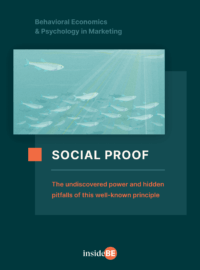When Rational Solutions Backfire and What You Have to be Careful About

Betting on rational solutions that make logical sense… well, that makes sense. But that doesn’t mean it’s always right. These are just a few of many examples of when reasonable solutions backfired. Learn why this happens and how you can avoid it.
In this article, you’ll discover:
- How very logical interventions backfired and reduced charitable donations by half;
- Why motivating people with money can actually make things worse; and
- What to do to make sure you’ll roll out the best possible solution.
Imagine your boss just hired a new guy to the team. He’s supposed to be some expert in behavioral economics, or whatever it’s called. But it’s the first time you’ve even heard of such a thing.
You work for a job ad portal and the first assignment you work on together is to increase the number of CVs sent through your portal. Since you’re compensated for every employee a company hires through your website, it’s quite a big one. One of the things you suggest is brilliant (or, at least, you think so).
How about telling the job seeker that part of the earnings would go to a charity? It makes perfect sense – it costs the candidates nothing and they’ll feel good about themselves, which should increase their motivation. Very logical, very rational.
The newbie, however, comes up with something ridiculous. He wants to list the number of resumes already submitted for every job ad. Why the heck would he do that? You don’t have to think hard to realize it will drive candidates away because the more resumes that have already been sent, the smaller their chances of getting hired.
The boss agreed to test both of these ideas, and you can’t help but wonder why he would hire a guy like this.
When judgment day comes and you have “I told you so” locked and loaded, your smile freezes. Results show that your solution backfired and performed even worse than the control group with no intervention at all. And the rookie? His unreasonable idea increased the number of resumes sent by 138%.

Discover ground-breaking ideas and fascinating solutions.
When can a rational solution backfire?
That, by the way, was a real-life example. Both of these solutions were tested by MINDWORX Behavioral Consulting when hired to help job ad company JobAngeles increase the number of resumes sent through their portal.
Social Proof
Social proof is our tendency to be influenced by what others do, how they think and behave. Social proof works particularly well in situations of uncertainty.
Showing the number of candidates that have already applied seems like a no-go, but in fact, it’s a well-known behavioral principle called social proof, which says that people tend to behave as others do. If a lot of people do something, then perhaps it’s a good idea to follow suit. And as you can see, it works.
This example certainly doesn’t stand alone when it comes to rational solutions backfiring and on the contrary, irrational ones striking the chord. But why does it happen?
Simply said, the assumption that people are rational decision-makers is wrong. It’s been proven over and over again, that we fall victim to many cognitive biases. We prefer to use intuitive shortcuts when making decisions instead of thinking hard and deciding based on strict logic. As the social proof mentioned above.
And your customers are no exceptions. They face too many decisions during their normal day and it’s much easier for them to go with intuition than with a rational mind. What does this mean for you?
For starters, you need to create solutions that appeal to their intuition, not just to their rational mind. There are multiple examples of how the rational solutions backfired. Let’s go through a couple of them, and at the end, we’ll talk about how you can prevent that from happening to you.
We prefer to use intuitive shortcuts when making decisions instead of thinking hard and deciding based on strict logic. You need to create solutions that appeal to intuition, not just to a rational mind.
An additional contribution to charity didn’t work, the quality of paper did
Let’s stick to the charity for a little bit. This example comes from Ogilvy UK and its attempt to increase charitable giving.
Every year, volunteers in the UK flood the streets with envelopes they put through people’s doors. A week later, they come back and collect it, hoping people threw some money for charity in. Ogilvy tested multiple interventions, let’s start with the rational one.
As you probably expect, it was very logical and made perfect sense. On the envelope, Ogilvy highlighted the fact that if donors tick the box Gift Aid, for every pound they contribute, the government adds an extra 25 pence minimum.
They assumed it would increase overall donations, because…why shouldn’t it? People will contribute even more than they threw in, and will be happy that the state will finally contribute to a good cause as well.
And the results? How Rory Sutherland, vice chairman of Ogilvy UK puts it, “Was it bollocks?” Well, this solution actually reduced the donation level by about 40 to 50%.
Other interventions Ogilvy tested made no logical sense whatsoever. They tried to make the envelopes from the higher quality paper and state on the envelope that it was hand-delivered by a volunteer.
Reciprocity
People’s natural tendency to reciprocate if they are given something first. Reciprocity is the strongest when what they receive is unexpected, valuable and personal.
Why would they think it would work? Because there are behavioral principles at play – reciprocity and perceived value. In short, these principles say that if we get something first, we tend to reciprocate and that people perceive the value of the service according to how much time and effort is invested in it.
And so, Ogilvy tried to make the envelopes from the higher quality paper and state on the envelope, that it was hand-delivered by a volunteer. And guess what, each of these increased the total donation level by 10%.
Perhaps the most surprising solution they tested was changing the orientation of the envelope by making the flap along the narrow edge instead of the broad edge. They assumed that people are more used to putting money in envelopes of such a format. And it turned out to be true, as this also increased donations by 10%.
If rolled out across the entire base, this would have brought in an extra half a million pounds. The other two “irrational” solutions would bring about £300 to £400,000.
Money is not the ultimate motivator
Fines led parents to even more problematic behavior
It’s only a matter of time before children finally understand they aren’t the only ones who can behave badly. Parents do that as well.
A certain Israeli kindergarten struggled with parents coming in late to pick up their children. First, they patiently monitored which parents were the guilty ones and arrived after 4 PM. Those were then fined 10 Israeli shekels per child — about $3 — if they picked up their children more than ten minutes late.
But – the number of latecomers didn’t decrease. In fact, it went up – from 25% to about 40%. Why? Because the fine replaced the established social norm and the guilt that parents felt with a price tag. Now, they could literally buy some time.
This came from the fundamental misunderstanding of the context in which the parents made their decisions. And the context, as behavioral economics has been teaching us for years, can be a very powerful weapon, even in marketing, sales, and CX.
Rewards can backfire as well
It’s no surprise that a lot of rational ideas involve rewarding people with money. We give people money and they will do what we want them to, right? Well, maybe. It depends. But oftentimes no.
There was a national referendum held in Switzerland back in the 90s on where it would site nuclear waste dumps. Researchers were asking citizens whether they would be willing to have a waste dump in their community. Surprisingly, 50% of voters said yes. They felt it was their civic duty as citizens – you take some, you give some.
Then, in an effort to increase the number, they asked them again, but this time they offered them six weeks’ worth of an average Swiss salary as compensation. The percentage of citizens agreeing with the waste in their community dropped to 25%
The money shifted the question from being a moral dilemma (I have obligations as a citizen) to a self-interest dilemma (is six weeks’ salary enough for me to have it in my neighborhood? No, it isn’t).
Money isn’t the answer to everything, even though it often seems so and perhaps it even makes sense. It has been repeatedly shown even in the work environment – you can only motivate employees so far with money.
Test multiple options and always consider the context
If there’s one thing you should take from this article, it’s not that you shouldn’t try rational solutions ever again. No siree Bob. Just keep in mind that it may backfire and that you should always test out multiple options. Even if it seems irrational at first. You will see which one performed the best and then roll it out.
The second thing is to always consider the context in which the decisions are made. How do they perceive your product now? Can their perception change after you roll out your new campaign? Is the decision we want them to change moral in nature?
Your customers, like everybody else, aren’t purely rational creatures. Their decision-making is mostly driven by intuitive shortcuts and biases. Your solutions should reflect that. This is a well-known fact for behavioral experts, yet marketers, business owners, copywriters, and product designers still rely on a rational mindset way too much.
Key Takeaways:
- When an idea is very logical and makes sense, it doesn’t mean it won’t do you wrong. Customers are irrational and decide intuitively. Your campaigns should reflect that as well.
- Whatever campaign you want to roll out, test it first. You may find that even an obscure idea can multiply your conversions, while reasonable ones didn’t work or even backfired.
- Consider the context in which customers decide. Is there any chance that your campaign will worsen the perception of your product? How is it perceived now?





